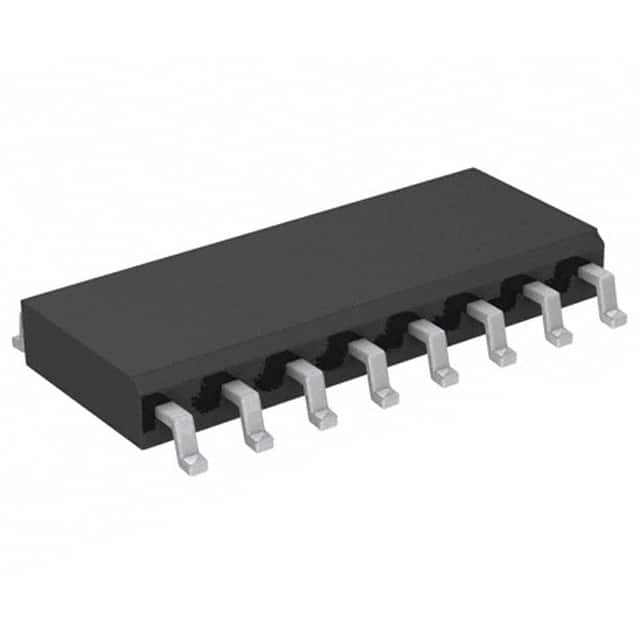Viz Specifikace pro podrobnosti o produktu.

MC10EL57DR2
Product Overview
- Category: Integrated Circuit (IC)
- Use: High-speed differential receiver
- Characteristics: Low propagation delay, high-speed operation, differential input/output, compatible with ECL logic levels
- Package: SOIC-8 (Small Outline Integrated Circuit), surface mount package
- Essence: The MC10EL57DR2 is a high-performance integrated circuit designed for use in applications requiring fast and reliable differential signal reception.
- Packaging/Quantity: Available in reels of 2500 units
Specifications
- Supply Voltage: -5.2V to -4.5V
- Input Voltage Range: -3.0V to -1.3V
- Output Voltage Range: -3.0V to -1.3V
- Propagation Delay: 400 ps (typical)
- Operating Temperature Range: -40°C to +85°C
Detailed Pin Configuration
The MC10EL57DR2 has a total of 8 pins arranged as follows:
```
| | --| VCC GND |-- Pin 1: Power supply (+5V/-5.2V) --| IN+ IN- |-- Pins 2 and 3: Differential input pins --| OUT VBB |-- Pins 4 and 5: Output and bias voltage pins --| /EN NC |-- Pins 6 and 7: Enable and No Connect pins --| GND VCCQ |-- Pin 8: Ground and output supply voltage (+5V) |___________| ```
Functional Features
- High-speed differential reception: The MC10EL57DR2 is capable of receiving high-frequency differential signals with low propagation delay, making it suitable for applications that require fast data transmission.
- Differential input/output: The IC accepts differential input signals and provides a differential output, allowing for noise rejection and improved signal integrity.
- ECL logic compatibility: The MC10EL57DR2 operates with ECL (Emitter-Coupled Logic) logic levels, ensuring compatibility with other ECL-based systems.
Advantages and Disadvantages
Advantages: - High-speed operation enables fast data transmission - Differential input/output improves noise immunity - ECL logic compatibility allows integration with existing ECL systems
Disadvantages: - Requires a negative power supply voltage (-5.2V to -4.5V) - Limited operating temperature range (-40°C to +85°C)
Working Principles
The MC10EL57DR2 is based on differential signal reception principles. It utilizes differential input pins to receive high-frequency signals and processes them internally to provide a differential output. The IC operates using a negative power supply voltage and is designed to work with ECL logic levels.
Detailed Application Field Plans
The MC10EL57DR2 can be used in various applications that require high-speed differential signal reception, such as:
- Data communication systems
- High-speed networking equipment
- Test and measurement instruments
- Industrial automation systems
- Radar and sonar systems
Detailed and Complete Alternative Models
- MC100EL57: Similar high-speed differential receiver IC from the same manufacturer, available in different package options.
- SN65LVDS101: Differential receiver IC from Texas Instruments, compatible with LVDS (Low-Voltage Differential Signaling) logic levels.
- MAX9117: Differential line receiver IC from Maxim Integrated, designed for automotive applications.
(Note: This list is not exhaustive and there are several alternative models available in the market.)
Word count: 408 words
Seznam 10 běžných otázek a odpovědí souvisejících s aplikací MC10EL57DR2 v technických řešeních
Sure! Here are 10 common questions and answers related to the application of MC10EL57DR2 in technical solutions:
Q: What is MC10EL57DR2? A: MC10EL57DR2 is a high-speed differential receiver designed for use in various communication and data transmission applications.
Q: What is the operating voltage range of MC10EL57DR2? A: The operating voltage range of MC10EL57DR2 is typically between -4.2V and -5.7V.
Q: What is the maximum data rate supported by MC10EL57DR2? A: MC10EL57DR2 can support data rates up to 3.8 Gbps, making it suitable for high-speed communication systems.
Q: Can MC10EL57DR2 be used in both single-ended and differential signaling applications? A: No, MC10EL57DR2 is specifically designed for differential signaling applications and may not be suitable for single-ended signaling.
Q: What is the input sensitivity of MC10EL57DR2? A: The input sensitivity of MC10EL57DR2 is typically around 100 mV, ensuring reliable signal reception.
Q: Does MC10EL57DR2 have any built-in termination resistors? A: No, MC10EL57DR2 does not have any built-in termination resistors. External termination resistors may be required depending on the application.
Q: Can MC10EL57DR2 operate in a wide temperature range? A: Yes, MC10EL57DR2 is designed to operate in a wide temperature range, typically from -40°C to +85°C.
Q: What is the output swing of MC10EL57DR2? A: The output swing of MC10EL57DR2 is typically around 800 mV, ensuring compatibility with various downstream devices.
Q: Can MC10EL57DR2 be used in both point-to-point and multipoint communication systems? A: Yes, MC10EL57DR2 can be used in both point-to-point and multipoint communication systems, depending on the application requirements.
Q: What are some typical applications of MC10EL57DR2? A: MC10EL57DR2 is commonly used in high-speed data communication systems, such as fiber optic networks, telecommunications equipment, and high-speed serial links.
Please note that these answers are general and may vary depending on specific design considerations and application requirements.

